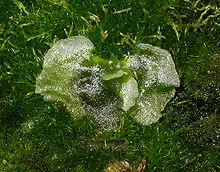Prothallium
As prothallium (from latin per "before" and Greek θαλλός thallos "sprout") is called in botany the haploid gametophyte of ferns and lycopodiopsida . It represents one of the two generations in the diplohaplontic generation change of these plants. Compared to the sporophyte , the “actual” plant, it is small, inconspicuous, mostly short-lived and hidden. Its function is to form gametes and thus enable sexual reproduction .
Manifestations of the prothallium
In the most common case - with the real ferns - the prothallium is a flat, often heart-shaped green thallus with a diameter of a few centimeters at most, which lies on the ground and is anchored in it with unicellular rhizoids . The prothallium of the horsetail , which today are counted among the ferns despite the completely different habitus of the sporophytes, is similar to that of the real ferns, but is strongly lobed. In contrast, the cylindrical prothallia of the adder tongue family and fork leaf family are free of chlorophyll, grow underground and are nourished by mycorrhizal fungi . This also applies to the nodular prothallia of the bear moss family , which do not belong to the ferns, but are related to them and have a matching life cycle. The bar moss family is also characterized by a very slow course of this subterranean phase of life: while the prothallium dies after a few weeks in the real ferns, the spore in the bar moss family goes through a six to seven year dormancy, followed by a further resting phase in a five-cell stage follows. Only after a mycorrhizal fungus has penetrated one of its cells does it develop further, and it only reaches sexual maturity after 12 to 15 years. Another trend is shown by the swimming fern family and the moss ferns and bream herbs , which are related to the barnacles , in which the male gametophyte in particular is greatly reduced and largely remains in the spore, so that no free-living prothallium occurs.
The generation change in the real ferns
Ferns are generally known as plants that are often bushy in our latitudes, with more or less long leaves ("fern fronds"), which occasionally have sporangia on the underside of their leaves in the form of points or stripes from which they release spores ; Spores are an asexual form of reproduction. Less noticeable, however, is the change in generation of ferns: The generally known form of the fern plants is the sporophyte (the plant that produces spores). However, the spores do not germinate into new sporophytes (ie not into the "fern frond plants"), but rather into the inconspicuous gametophytes (= prothallia), i. H. to a plant producing gametes (sex cells, germ cells).
Prothallia anchor themselves in the ground with rhizoids . Gametangia , in which the gametes are formed, then develop on the underside of the mostly flat prothallia : male germ cells, the spermatozoids, develop in mostly spherical antheridia , and the egg cells in bottle-shaped archegonia .
In almost all fern species, antheridia and archegonia are present on the same prothallium ( monoecious ferns), only in Platyzoma (Gleicheniaceae) are they on different prothallia ( dioecious ferns); in some ferns, this gender separation already occurs in the sporangia (isospore vs. heterospore ferns).
When the spermatozoids are released from the antheridia, they swim - similar to the sperm in animals - with the help of their flagella to an archegonium; the movement and thus the fertilization of the egg can only take place in the presence of drip water. The well-known fern plant with its characteristic fronds, the sporophyte, then grows from the fertilized egg cell ( zygote ).
Self-fertilization is usually prevented by the fact that the antheridia are formed at an early stage of development and release spermatozoids, while the archegonia of the same prothallium only arise when ample reserve material has been stored through photosynthesis ( proterandry ).
Web links
Individual evidence
- ^ Dietrich von Denffer , Friedrich Ehrendorfer , Karl Mägdefrau , Hubert Ziegler : Textbook of Botany. 31st edition, Gustav Fischer Verlag, Stuttgart and New York 1978, pp. 661, 688.
- ^ Joachim W. Kadereit, Christian Körner, Benedikt Kost, Uwe Sonnewald: Strasburger Textbook of Plant Sciences . Springer Spectrum, Berlin / Heidelberg 2014, p. 630.
- ^ Dietrich von Denffer , Friedrich Ehrendorfer , Karl Mägdefrau , Hubert Ziegler : Textbook of Botany. 31st edition, Gustav Fischer Verlag, Stuttgart and New York 1978, pp. 683f.
- ^ Joachim W. Kadereit, Christian Körner, Benedikt Kost, Uwe Sonnewald: Strasburger Textbook of Plant Sciences . Springer Spectrum, Berlin / Heidelberg 2014, p. 623f.
- ^ Dietrich von Denffer , Friedrich Ehrendorfer , Karl Mägdefrau , Hubert Ziegler : Textbook of Botany. 31st edition, Gustav Fischer Verlag, Stuttgart and New York 1978, p. 668.
- ^ Dietrich von Denffer , Friedrich Ehrendorfer , Karl Mägdefrau , Hubert Ziegler : Textbook of Botany. 31st edition, Gustav Fischer Verlag, Stuttgart and New York 1978, pp. 696f.
- ^ Matthias Baltisberger, Reto Nyffeler and Alex Widmer: Systematic Botany. 4th edition, vdf Hochschulverlag, Zurich 2013, p. 43, ISBN 978-3-7281-3525-4
- ^ Dietrich von Denffer , Friedrich Ehrendorfer , Karl Mägdefrau , Hubert Ziegler : Textbook of Botany. 31st edition, Gustav Fischer Verlag, Stuttgart and New York 1978, p. 688.
